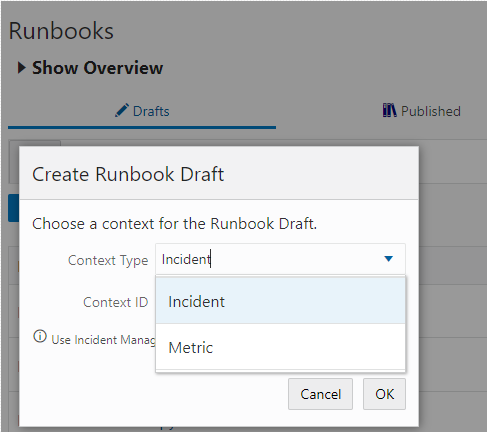Working with Dynamic Runbooks
At a high level, working with Dynamic Runbooks involves the following workflows:
Create a New Dynamic Runbook
You can create a Runbook in one of three ways:
You can go to Incident Manager, choose the incident for which you want to create a Runbook, and then click on the Create Runbook link.

Go to the All Metrics page of a target homepage and select the metric for which you would like to create a runbook. In the Runbook Sessions section, click on Create Runbook link.

Alternatively, you create a Runbook by creating a Runbook Draft and then specify the context and the context ID for which you would like to create a Runbook. The context ID can either be an Incident context or Metric context. For Incidents, get the Incident ID from Incident Manager. For Metrics, get the metric context from the Runbook Sessions section associated with the metric in the target's All Metrics page.

In all these ways, choosing the incident or metric will provide the context that will be used to develop and test the Runbook steps. Once the Runbook is complete, you can publish the Runbook.
Create a New Version of a Dynamic Runbook
You create a new version of a published Dynamic Runbook by creating a Runbook draft from the Runbook, editing the steps and re-publishing the Runbook. When you publish the new version of the Runbook, the new published version replaces the prior version.

Use a Published Dynamic Runbook
By executing a Dynamic Runbook from the context of an incident or metric, a Runbook session is created.

Types of Dynamic Runbook Users
There are different types of Dynamic Runbook users that play specific roles in the creation, running, and administrative maintenance of Runbooks.
- Runbook Author
This user can:
- Create and publish Runbooks
- Show/hide published Runbooks
Create Runbooks privilege is required.
- Runbook User
This user can:
- Execute published Runbooks (start Runbook session)
- If a user can see an incident, they can execute the Runbook session
All Enterprise Manager Users are Runbook users.
- Runbook Administrator
This user can:
- Delete and show/hide on any Runbook
- Show/hide published Runbooks
- List and delete Runbook sessions marked done that have been created by other users
- Extend expiry of any runbook session marked done
- View Runbook session data without access to incidents/jobs
Manage Runbooks privilege is required.
Note:
The Enterprise Manager Super Administrator has complete access to all facets of the Runbook lifecycle (creation, administration, editing, publication)Accessing Dynamic Runbooks
From the Enterprise Manager console, you can access Runbooks from the following locations:
Runbooks List Page
From the Enterprise menu, select Monitoring and then Runbooks. The Runbooks page displays all Published Runbooks. If you have the Create Runbooks privilege, you will also see available Runbook drafts. You can initiate Runbook draft creation from this page. However, the recommended way to create an new Runbook is from Incident Manager, in context of the incident for which you want to create a Runbook.
Runbook Sessions Page
From the Enterprise menu, select Monitoring and then Runbook Sessions. Here, you'll see a list of Runbook sessions you own (both active and done). To start a new Runbook session, go to Incident Manager, locate the incident for which you would like to start a Runbook session, then click on the option to Start Runbook Session.
Target's All Metrics Page
From any target homepage menu, select Monitoring then All Metrics. When you choose a metric from the list of metrics, a Runbook Sessions section will be available next to the metric chart. From here you can start a Runbook session from any available runbooks for that metric or create a new Runbook in context of that metric.
Incident Manager
From the Enterprise menu, select Monitoring and then Incident Manager. When you click on a particular incident, you'll see any Runbook sessions created for that incident. You'll also have the option to view the top (up to three) Runbooks that may be relevant to the incident (see Relevant Runbooks for more information). From here, you'll be able to start a Runbook session or create a new Runbook within the context of the incident.
All Metrics
In the target instance homepage, from the target menu, select Monitoring and then All Metrics. When you click on a particular metric in a metric group, you will see a Runbooks section similar to the one you would see in Incident Manager with all of the same options for starting a Runbook session or creating a new Runbook draft.